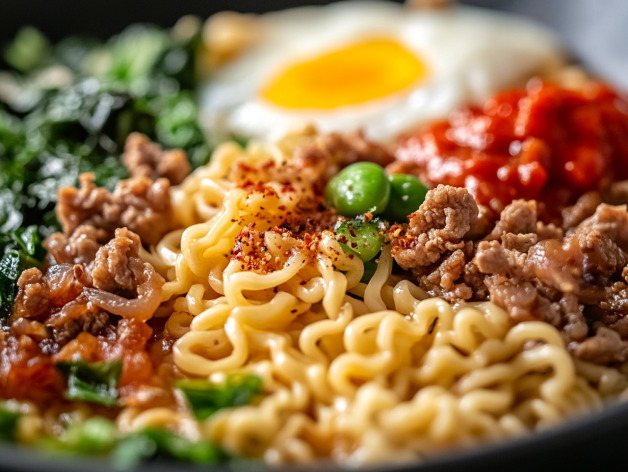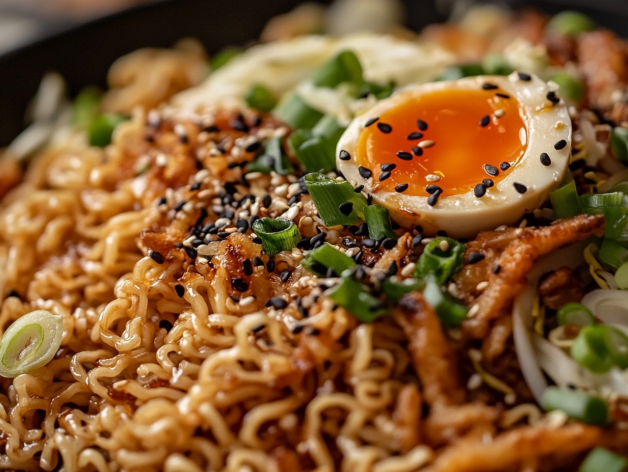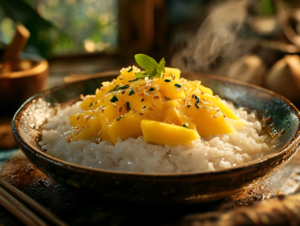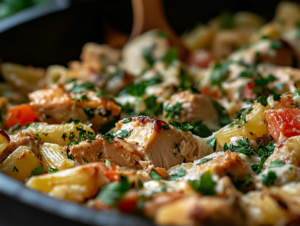If you’re craving the comfort of ramen but want something crispier, more flavorful, and less messy, this Sheet-Pan Crispy Ramen is your new go-to. It combines tender chicken, vibrant vegetables, and springy noodles—all caramelized to perfection under the broiler. It’s fast, customizable, and packed with umami. Whether you’re feeding a family or meal-prepping for the week, this one-pan wonder delivers big flavor with minimal cleanup.
Why You’ll Love This Recipe
-
Crispy Texture: The broiler transforms ramen noodles into golden, crunchy strands.
-
One-Pan Simplicity: Everything cooks on a single sheet pan—less mess, more flavor.
-
Customizable: Swap proteins or veggies based on what you have.
-
Quick & Easy: Ready in just 30 minutes.
-
Meal Prep Friendly: Leftovers keep well for up to 4 days.
Ingredients
For the Sauce:
-
3 tablespoons reduced-sodium soy sauce
-
3 tablespoons toasted sesame oil
-
2 tablespoons oyster sauce
-
1 tablespoon pure maple syrup
-
1 tablespoon sriracha (plus more for serving, optional)
-
2 teaspoons chicken bouillon
For the Main Dish:
-
1 pound boneless, skinless chicken thighs or breasts, sliced crosswise into 1/2-inch-thick pieces
-
2 garlic cloves, finely chopped or grated
-
1 tablespoon finely grated peeled ginger
-
1 bunch of scallions, cut into 1-inch pieces
-
1 pound broccoli, cut into 1/2-inch florets
-
8 ounces snow peas, trimmed
-
2 tablespoons vegetable oil
-
Kosher salt
-
Freshly ground black pepper
-
4 (3-ounce) packages ramen noodles, seasoning packets discarded
-
Toasted sesame seeds, for serving
Directions
-
Preheat and Prepare Sauce: Arrange a rack in the upper third of the oven and heat the broiler. In a small bowl, whisk together soy sauce, sesame oil, oyster sauce, maple syrup, sriracha, and chicken bouillon.
-
Marinate Chicken: In a medium bowl, toss the sliced chicken with garlic, ginger, and 2 tablespoons of the prepared sauce. Reserve the remaining sauce.
-
Prepare Vegetables: On a large sheet pan, toss scallions, broccoli, and snow peas with vegetable oil, 1/2 teaspoon salt, and 1/4 teaspoon pepper. Spread the vegetables evenly, then arrange the marinated chicken pieces over them.
-
Broil Chicken and Vegetables: Broil, watching closely, until the chicken is browned and cooked through, about 3 to 5 minutes.
-
Cook Ramen Noodles: While the chicken and vegetables are broiling, bring a large pot of salted water to a boil. Cook the ramen noodles according to package instructions. Drain and rinse with cold water to prevent sticking.
-
Combine and Broil Again: Add the cooked noodles and the reserved sauce to the sheet pan. Toss everything together to combine and spread into an even layer. Broil again, watching closely, until the noodles are crispy and the broccoli is crisp-tender, about 5 to 7 minutes. For extra crispy noodles, toss and spread them again into an even layer and broil for an additional 3 to 5 minutes.
-
Serve: Top with toasted sesame seeds and additional sriracha if desired.
Nutritional Information (Per Serving)
-
Calories: Approximately 781
-
Protein: Varies based on ingredients used
-
Carbohydrates: Varies based on ingredients used
-
Fat: Varies based on ingredients used
-
Sodium: Varies based on ingredients used
Note: Nutritional values are approximate and can vary based on specific ingredients used.
Recipe Details
-
Servings: 4 to 6
-
Prep Time: 15 minutes
-
Cooking Time: 15 minutes
-
Total Time: 30 minutes
Variations & Substitutions
-
Vegetarian Option: Omit chicken and substitute with mushrooms or tofu.
-
Vegetable Swaps: Use cabbage, carrots, baby corn, or bell peppers in place of or in addition to the listed vegetables.
-
Spice Level: Adjust sriracha to taste or omit for a milder dish.
The Secret to Crispy Ramen Noodles Without Frying
One of the standout features of this dish is its incredible texture—specifically, those crave-worthy crispy noodles that feel like something out of a restaurant kitchen. Traditionally, achieving that signature crunch requires deep frying, which is not only messy but adds unnecessary oil and cleanup. Here’s the secret: using your oven’s broiler and a well-drained layer of cooked ramen. When ramen noodles are cooked, drained, and then broiled with a thin coating of oil and sauce, they develop a crunchy golden crust while retaining their chewy interior—think crispy edges and soft centers. The key is spreading the noodles in a flat, even layer on the sheet pan and resisting the urge to pile them up. Give them enough space and you’ll be rewarded with evenly crisped, caramelized strands that soak up every bit of the umami-packed sauce. Want to go even crispier? After the first broil, give the noodles a gentle toss, spread them again, and return them to the broiler for a second round. The result is noodle magic—no frying required.
Choosing the Right Ramen for This Recipe
Not all ramen is created equal, especially when it comes to a sheet-pan recipe where texture and durability are essential. While those inexpensive 3-ounce ramen packs from the store are perfectly acceptable and even encouraged for this dish, you might be surprised to learn that opting for a slightly higher-quality ramen can take things up a notch. Look for noodles that list “wheat flour” as the first ingredient and have a springy texture when cooked. Avoid noodles that turn mushy quickly—these won’t hold up under the broiler and may clump together rather than crisp up. If you’re shopping at an Asian market, fresh or refrigerated ramen can be an excellent upgrade, although you’ll need to monitor them closely under the broiler since they crisp faster. If you’re going gluten-free, soba or rice noodles could work in a pinch, but note that they won’t have the same firm, bouncy texture or develop the same level of crispiness. And whatever you do, skip the seasoning packets that come with the ramen—this recipe’s sauce is packed with flavor and more balanced in sodium, spice, and depth.
The Power of Sheet-Pan Cooking
There’s a reason sheet-pan meals have become a staple for busy home cooks—they’re convenient, low-mess, and incredibly adaptable. But for this particular dish, the sheet pan isn’t just a convenience; it’s a cooking technique that delivers unique benefits you can’t get from stovetop stir-frying alone. When ingredients like chicken, vegetables, and noodles are exposed directly to the high heat of the broiler on a flat surface, they caramelize and crisp beautifully. The rendered fat from the chicken and the oils from the sauce meld with the vegetables and noodles, creating golden brown bits of flavor you simply can’t replicate in a sauté pan. Plus, the uniform exposure to heat ensures even cooking—no soggy vegetables or rubbery chicken here. Sheet-pan cooking also allows for hands-free moments: while everything’s in the oven, you’re free to clean up, prep garnishes, or just relax. And cleanup? A quick rinse of the sheet pan (especially if you line it with foil or parchment paper) and you’re done. One pan, maximum flavor.
Sauce Science: Balancing Sweet, Salty, and Umami
The backbone of this recipe is undoubtedly the sauce—a deeply flavorful mixture that ties everything together with bold Asian-inspired notes. Understanding the balance of sweet, salty, and umami can help you tweak the sauce to suit your taste perfectly. Soy sauce is the salty base, offering that familiar fermented richness. Sesame oil adds nuttiness and a toasty depth that enhances the ramen’s crispness. Oyster sauce contributes a thick, almost syrupy umami note that clings beautifully to the noodles and vegetables, making every bite more flavorful. Maple syrup is the not-so-secret sweetener here, lending subtle caramel notes without overpowering the savory elements. And of course, sriracha brings the heat—just enough to warm the tongue, not scorch it. This sauce is bold, balanced, and designed to glaze, not soak. It coats the ingredients lightly so they caramelize under the broiler instead of becoming soggy. You can customize it by swapping maple syrup for honey, adding a splash of rice vinegar for tang, or throwing in a touch of hoisin or miso paste for extra umami. The goal is harmony—flavors that sing together rather than compete.
Make-Ahead Tips and Storage Advice
One of the many reasons to love this sheet-pan crispy ramen is how well it fits into a meal-prep lifestyle. If you want to save time on a busy weeknight, prep the components in advance. The sauce can be made up to five days ahead and stored in a sealed jar in the fridge—just give it a shake before using. You can also chop the vegetables and marinate the chicken up to 24 hours in advance. Even the ramen noodles can be cooked ahead of time; just rinse them well, toss them with a bit of oil to prevent sticking, and refrigerate until you’re ready to broil. Once cooked, leftovers store beautifully. Let everything cool completely before transferring it to an airtight container. It’ll keep for up to four days in the fridge. When reheating, avoid the microwave, which can make the noodles rubbery. Instead, spread the leftovers on a baking sheet and reheat under the broiler or in a hot oven for about 5–7 minutes. That way, you bring back some of the crisp and freshness—almost like it was just made. Whether you’re prepping meals for the week or saving dinner for the next day, this dish is as reliable as it is delicious.
Tips for Success
-
Watch Closely While Broiling: Broilers can vary in intensity; keep an eye on the dish to prevent burning.
-
Even Layering: Spread ingredients evenly on the sheet pan to ensure uniform cooking and crispiness.
-
Leftovers: Store in an airtight container in the refrigerator for up to 4 days. Reheat in the oven or a skillet to maintain crispiness.
Final Thoughts
This Sheet-Pan Crispy Ramen is a delightful twist on a classic comfort food, offering a perfect balance of textures and flavors. It’s versatile, easy to prepare, and sure to become a staple in your meal rotation. Give it a try and enjoy the crispy, savory goodness!
Print
Sheet-Pan Crispy Ramen: The Ultimate Weeknight Dinner Hack
Description
For the Sauce:
-
3 tablespoons reduced-sodium soy sauce
-
3 tablespoons toasted sesame oil
-
2 tablespoons oyster sauce
-
1 tablespoon pure maple syrup
-
1 tablespoon sriracha (plus more for serving, optional)
-
2 teaspoons chicken bouillon
For the Main Dish:
-
1 pound boneless, skinless chicken thighs or breasts, sliced crosswise into 1/2-inch-thick pieces
-
2 garlic cloves, finely chopped or grated
-
1 tablespoon finely grated peeled ginger
-
1 bunch of scallions, cut into 1-inch pieces
-
1 pound broccoli, cut into 1/2-inch florets
-
8 ounces snow peas, trimmed
-
2 tablespoons vegetable oil
-
Kosher salt
-
Freshly ground black pepper
-
4 (3-ounce) packages ramen noodles, seasoning packets discarded
-
Toasted sesame seeds, for serving
Ingredients
-
Preheat and Prepare Sauce: Arrange a rack in the upper third of the oven and heat the broiler. In a small bowl, whisk together soy sauce, sesame oil, oyster sauce, maple syrup, sriracha, and chicken bouillon.
-
Marinate Chicken: In a medium bowl, toss the sliced chicken with garlic, ginger, and 2 tablespoons of the prepared sauce. Reserve the remaining sauce.
-
Prepare Vegetables: On a large sheet pan, toss scallions, broccoli, and snow peas with vegetable oil, 1/2 teaspoon salt, and 1/4 teaspoon pepper. Spread the vegetables evenly, then arrange the marinated chicken pieces over them.
-
Broil Chicken and Vegetables: Broil, watching closely, until the chicken is browned and cooked through, about 3 to 5 minutes.
-
Cook Ramen Noodles: While the chicken and vegetables are broiling, bring a large pot of salted water to a boil. Cook the ramen noodles according to package instructions. Drain and rinse with cold water to prevent sticking.
-
Combine and Broil Again: Add the cooked noodles and the reserved sauce to the sheet pan. Toss everything together to combine and spread into an even layer. Broil again, watching closely, until the noodles are crispy and the broccoli is crisp-tender, about 5 to 7 minutes. For extra crispy noodles, toss and spread them again into an even layer and broil for an additional 3 to 5 minutes.
-
Serve: Top with toasted sesame seeds and additional sriracha if desired.





